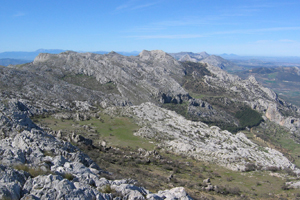Calculating recharge of groundwater more precisely

A karst region in Andalusia, Southern Spain. Photo: Matías Mudarra, Universität Malaga/Spanien
A team of international researchers led by University of Freiburg hydrologist Dr. Andreas Hartmann suggests that inclusion of currently missing key hydrological processes in large-scale climate change impact models can significantly improve our estimates of water availability. The study shows that groundwater recharge estimates for 560 million people in karst regions in Europe, the Middle East and Northern Africa, are much higher than previously estimated from current large-scale models.
The scientists have shown that model estimates based on entire continents up to now have greatly underestimated in places the amount of groundwater that is recharged from fractions of surface runoff. This finding suggests that more work is needed to ensure sufficient realism in large-scale hydrologic models before they can be reliably used for local water management. The team has published their research findings in the scientific journal “Proceedings of the National Academy of Sciences (PNAS).“
Groundwater is a vital resource in many regions around the globe. For managing drinking water, the recharge rate is an important quantity for securing sustainable supplies. The researchers have compared two hydrological models that simulate groundwater recharge. One is a long-established global model with limited accounting for subsurface heterogeneity.
The other is a continental model the researchers have developed themselves that includes, for example, variability in the thickness of soils and different subsurface permeabilities. They have carried out the comparison for all of the karst regions in Europe, North Africa and the Middle East. Karst regions are known for their great degree of subsurface heterogeneity, because carbonate rock shows greater susceptibility to chemical weathering – a process that is known as karstification.
Karstification leads to varying soil depths and permeabilities. A comparison of the models' calculations with independent observations of groundwater recharge at 38 sites in the regions has shown that the model that accounts for heterogeneity produces more realistic estimates.
The researchers explain the reason for the difference between the two models as follows: In simulation, their newly developed model shows reduced fractions of surface According to the new model, a farmer in the Mediterranean region would potentially have up to a million liters more groundwater for extraction available in a year than the established model estimates, dependent on actual subsurface composition and the water demands of the local ecosystems.
When applied to the example of karst regions, the researchers' approach shows how it is possible to adapt global models used to predict water shortages, drought or floods to account more realistically for regional conditions. Scientists from the University of Freiburg, Canada's Victoria University, the University of Bristol in England and International Institute for Applied Systems Analysis in Austria took part in the study.
Original publication
Hartmann, A., Gleeson, T., Wada, Y., Wagener, T., 2017. Enhanced groundwater recharge rates and altered recharge sensitivity to climate variability through subsurface heterogeneity. In: “Proceedings of the National Academy of Sciences”; doi:10.1073/pnas.1614941114.
Contact:
Dr. Andreas Hartmann
Chair of Hydrology
University of Freiburg
Tel.: 0761/203-3520
E-Mail: andreas.hartmann@hydrology.uni-freiburg.de
https://www.pr.uni-freiburg.de/pm/2017/pm.2017-02-28.25-en?set_language=en
Media Contact
All latest news from the category: Ecology, The Environment and Conservation
This complex theme deals primarily with interactions between organisms and the environmental factors that impact them, but to a greater extent between individual inanimate environmental factors.
innovations-report offers informative reports and articles on topics such as climate protection, landscape conservation, ecological systems, wildlife and nature parks and ecosystem efficiency and balance.
Newest articles

Security vulnerability in browser interface
… allows computer access via graphics card. Researchers at Graz University of Technology were successful with three different side-channel attacks on graphics cards via the WebGPU browser interface. The attacks…

A closer look at mechanochemistry
Ferdi Schüth and his team at the Max Planck Institut für Kohlenforschung in Mülheim/Germany have been studying the phenomena of mechanochemistry for several years. But what actually happens at the…

Severe Vulnerabilities Discovered in Software to Protect Internet Routing
A research team from the National Research Center for Applied Cybersecurity ATHENE led by Prof. Dr. Haya Schulmann has uncovered 18 vulnerabilities in crucial software components of Resource Public Key…





















